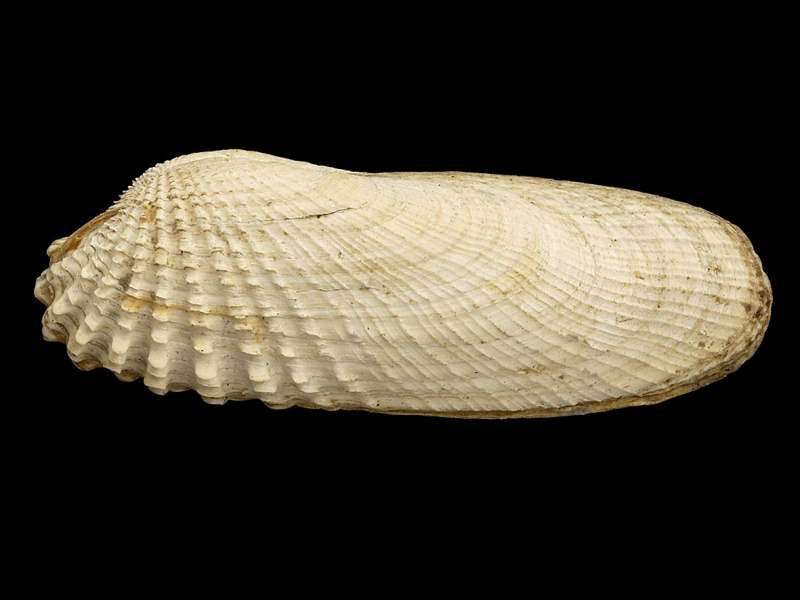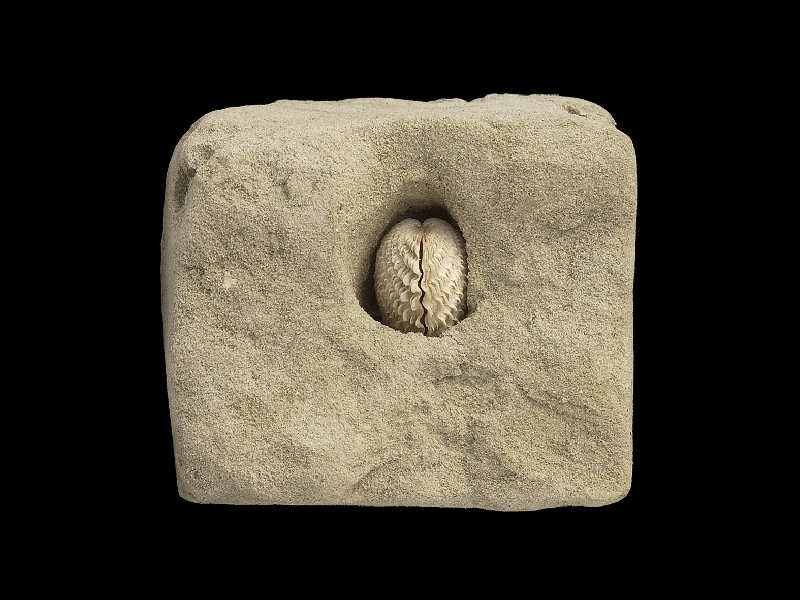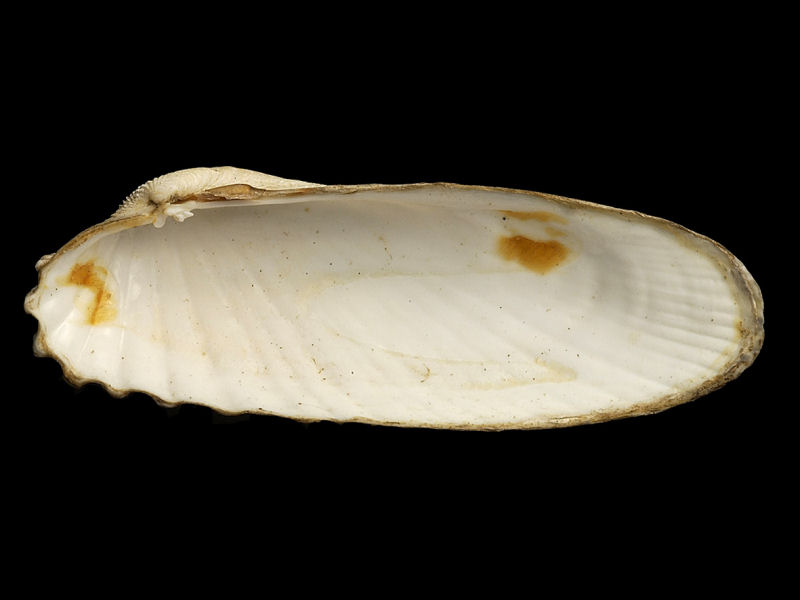American piddock (Petricolaria pholadiformis)
Distribution data supplied by the Ocean Biodiversity Information System (OBIS). To interrogate UK data visit the NBN Atlas.Map Help
| Researched by | Georgina Budd | Refereed by | Admin |
| Authority | (Lamarck, 1818) | ||
| Other common names | - | Synonyms | Petricolaria pholadiformis (Lamarck, 1818), Petricola pholadiformis |
Summary
Description
Recorded distribution in Britain and Ireland
Present along south and east coasts of England from Lyme Regis, Dorset, to the Humber. It is most common off the coast of Essex and the Thames estuary (River Medway) (Duval, 1963a; Bamber, 1985). Isolated records from north Wales and Cornwall.Global distribution
Occurs from southern Norway to the Mediterranean and Black Seas, and along the west coast of Africa from Senegal to the French Congo. In North America it ranges from Prince Edward Island to the Gulf of Mexico, and is also present in California.Habitat
Petricolaria pholadiformis is a mechanical borer into hard clay, chalk, solid mud, peat-moss and limestone from the mid-tide level to low water. Although dredged from a depth of 8 m, its occurrence in deeper water is not known (Tebble, 1967).Depth range
-Identifying features
- Thin, brittle, equivalve and inequilateral shell.
- Beaks in anterior half, turned downwards and inwards, sometimes set back from dorsal edge.
- Shell elongate and oval in outline.
- Shell, off-white or fawn in colour, with dark brown periostracum.
- Sculpturing of concentric rings crossed anteriorly by about 40 ribs, that are spined at the anterior end.
- Ligament prominent.
- Interior of shell white, with the coarse anterior ribs showing through.
- Anterior margin of shell crenulate where the large ribs meet it, elsewhere smooth.
- Petricola pholadiformis bears a superficial resemblance to Barnea candida, but has 2 cardinal teeth in the right valve and 3 in the left valve where Barnea candida has none.
Additional information
Common namesPetricolaria pholadiformis may also be known as the 'false angel wing'.
Method of introduction and spread
Petricolaria pholadiformis is a non-native, boring piddock that was unintentionally introduced from America with the American oyster, Crassostrea virginica, not later than 1890 (Naylor, 1957). Rosenthal (1980) suggested that from the British Isles, the species has colonized several northern European countries by means of its pelagic larva and may also spread via driftwood, although it usually bores into clay, peat or soft rock shores.
In Belguim and The Netherlands Petricolaria pholadiformis has almost completely displaced the native piddock, Barnea candida (ICES, 1972). However, there is no documentary evidence to suggest that native piddocks have been displaced in the British Isles (J.Light & I.Kileen pers. comm. to Eno et al., 1997).
Listed by
- none -
Bibliography
Abbott, R.T., 1974. American seashells: the marine mollusca of the Atlantic and Pacific coast of North America, 2nd edn. New York: Van Nostrand.
Bamber, R.N., 1985. Coarse substrate benthos of Kingsnorth outfall lagoon, with observations on Petricola pholadiformis Lamarck. Central Electricity Research Laboratories Report TPRD/L2759/N84., Central Electricity Research Laboratories Report TPRD/L2759/N84.
Duval, D.M., 1963a. The biology of Petricola pholadiformis Lamarck (Lammellibranchiata: Petricolidae). Proceedings of the Malacological Society, 35, 89-100.
Eno, N.C., Clark, R.A. & Sanderson, W.G. (ed.) 1997. Non-native marine species in British waters: a review and directory. Peterborough: Joint Nature Conservation Committee.
Howson, C.M. & Picton, B.E., 1997. The species directory of the marine fauna and flora of the British Isles and surrounding seas. Belfast: Ulster Museum. [Ulster Museum publication, no. 276.]
ICES (International Council for the Exploration of the Sea), 1972. Report of the working group on the introduction of non-indigenous marine organisms. ICES: International Council for the Exploration of the Sea., ICES: International Council for the Exploration of the Sea.
JNCC (Joint Nature Conservation Committee), 1999. Marine Environment Resource Mapping And Information Database (MERMAID): Marine Nature Conservation Review Survey Database. [on-line] http://www.jncc.gov.uk/mermaid
Naylor, E., 1957. Immigrant marine animals in Great Britain. New Scientist, 2, 21-53.
Rosenthal, H., 1980. Implications of transplantations to aquaculture and ecosystems. Marine Fisheries Review, 42, 1-14.
Tebble, N., 1976. British Bivalve Seashells. A Handbook for Identification, 2nd ed. Edinburgh: British Museum (Natural History), Her Majesty's Stationary Office.
Wouters, D., 1993. 100 jaar na de invasie van de Amerikaanse boormossel: de relatie Petricola pholadiformis Lamarck, 1818, Barnea candida, Linnaeus, 1758. De Strandvlo, 13, 3-39.
Datasets
Conchological Society of Great Britain & Ireland, 2018. Mollusc (marine) data for Great Britain and Ireland - restricted access. Occurrence dataset: https://doi.org/10.15468/4bsawx accessed via GBIF.org on 2018-09-25.
Conchological Society of Great Britain & Ireland, 2018. Mollusc (marine) records for Great Britain and Ireland. Occurrence dataset: https://doi.org/10.15468/aurwcz accessed via GBIF.org on 2018-09-25.
Fenwick, 2018. Aphotomarine. Occurrence dataset http://www.aphotomarine.com/index.html Accessed via NBNAtlas.org on 2018-10-01
Kent Wildlife Trust, 2018. Kent Wildlife Trust Shoresearch Intertidal Survey 2004 onwards. Occurrence dataset: https://www.kentwildlifetrust.org.uk/ accessed via NBNAtlas.org on 2018-10-01.
National Trust, 2017. National Trust Species Records. Occurrence dataset: https://doi.org/10.15468/opc6g1 accessed via GBIF.org on 2018-10-01.
NBN (National Biodiversity Network) Atlas. Available from: https://www.nbnatlas.org.
Norfolk Biodiversity Information Service, 2017. NBIS Records to December 2016. Occurrence dataset: https://doi.org/10.15468/jca5lo accessed via GBIF.org on 2018-10-01.
OBIS (Ocean Biodiversity Information System), 2024. Global map of species distribution using gridded data. Available from: Ocean Biogeographic Information System. www.iobis.org. Accessed: 2024-04-20
South East Wales Biodiversity Records Centre, 2018. INNS Data: All Taxa (South East Wales). Occurrence dataset: https://doi.org/10.15468/crhjs2 accessed via GBIF.org on 2018-10-02.
South East Wales Biodiversity Records Centre, 2018. SEWBReC Molluscs (South East Wales). Occurrence dataset: https://doi.org/10.15468/jos5ga accessed via GBIF.org on 2018-10-02.
Citation
This review can be cited as:
Last Updated: 17/10/2005





